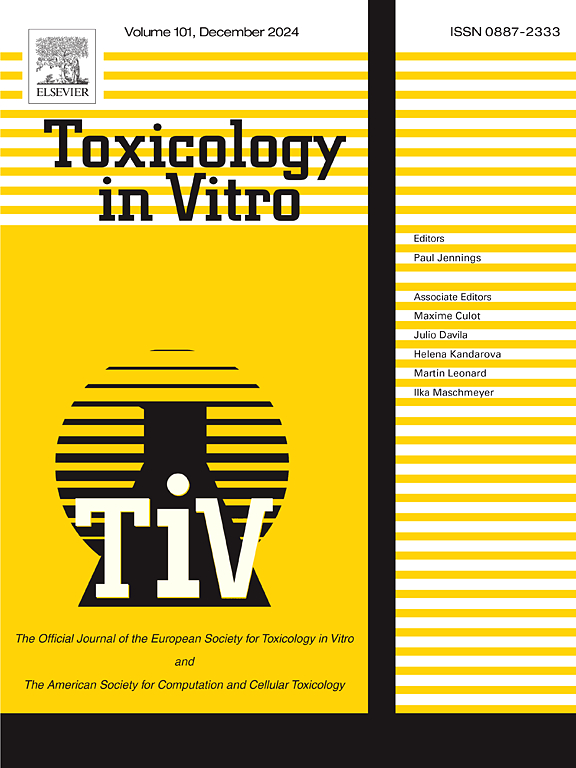Prolonged exposure to simvastatin affects coenzyme Q9/10 status leading to impaired mitochondrial respiratory capacity and reduced viability of cultured cardiac cells
IF 2.6
3区 医学
Q3 TOXICOLOGY
引用次数: 0
Abstract
This study investigates the effects of prolonged simvastatin exposure on coenzyme Q9/10 (CoQ9/10) levels, an essential component of antioxidant defense, in cultured cardiac cells. Statins, commonly used to manage dyslipidemia and reduce cardiovascular risk, may impair mitochondrial function, but their impact on CoQ10 depletion and oxidative stress is not well understood. We examined the influence of simvastatin on mitochondrial oxidative capacity, reactive oxygen species (ROS) production, and CoQ9/10 status at concentrations of 0.3, 0.6, 1.25, 2.5, 5, 10, and 20 μM, over durations of 24, 48, and 72 h. Using an in vitro model of cultured H9c2 cardiomyoblasts, our results showed that short-term exposure (24 h) at lower concentrations (<5 μM) enhanced cytosolic and mitochondrial ROS levels without affecting mitochondrial function or CoQ9/10 status. However, prolonged exposure to higher concentrations (≥10 μM for >48 h) resulted in impaired mitochondrial oxidative capacity, indicated by increased proton leak and elevated ROS levels, which were followed by significantly reduced cell viability. These findings suggest that prolonged, high-dose simvastatin exposure may disrupt the oxidative balance of CoQ9/10, leading to myocardial injury. This research addresses a gap in understanding the long-term effects of statins on mitochondrial health and underscores the need for further studies to optimize statin therapy and minimize adverse effects on myocardial function.
长期暴露于辛伐他汀影响辅酶Q9/10状态,导致线粒体呼吸能力受损和培养心脏细胞活力降低。
本研究探讨了辛伐他汀长期暴露对培养心肌细胞中辅酶Q9/10 (CoQ9/10)水平的影响,辅酶Q9/10是抗氧化防御的重要组成部分。他汀类药物通常用于控制血脂异常和降低心血管风险,可能损害线粒体功能,但其对辅酶q10消耗和氧化应激的影响尚不清楚。我们检测了辛伐他汀在0.3、0.6、1.25、2.5、5、10和20 μM浓度下对线粒体氧化能力、活性氧(ROS)产生和CoQ9/10状态的影响,持续时间为24、48和72 h。使用体外培养的H9c2心肌细胞模型,我们的结果显示,在较低浓度(9/10状态)下短期暴露(24 h)。然而,长时间暴露于较高浓度(≥10 μM / >48 h)会导致线粒体氧化能力受损,表现为质子泄漏增加和ROS水平升高,随后细胞活力显著降低。这些发现表明,长期高剂量的辛伐他汀暴露可能会破坏CoQ9/10的氧化平衡,导致心肌损伤。这项研究填补了他汀类药物对线粒体健康长期影响的空白,并强调了进一步研究优化他汀类药物治疗和减少对心肌功能不利影响的必要性。
本文章由计算机程序翻译,如有差异,请以英文原文为准。
求助全文
约1分钟内获得全文
求助全文
来源期刊

Toxicology in Vitro
医学-毒理学
CiteScore
6.50
自引率
3.10%
发文量
181
审稿时长
65 days
期刊介绍:
Toxicology in Vitro publishes original research papers and reviews on the application and use of in vitro systems for assessing or predicting the toxic effects of chemicals and elucidating their mechanisms of action. These in vitro techniques include utilizing cell or tissue cultures, isolated cells, tissue slices, subcellular fractions, transgenic cell cultures, and cells from transgenic organisms, as well as in silico modelling. The Journal will focus on investigations that involve the development and validation of new in vitro methods, e.g. for prediction of toxic effects based on traditional and in silico modelling; on the use of methods in high-throughput toxicology and pharmacology; elucidation of mechanisms of toxic action; the application of genomics, transcriptomics and proteomics in toxicology, as well as on comparative studies that characterise the relationship between in vitro and in vivo findings. The Journal strongly encourages the submission of manuscripts that focus on the development of in vitro methods, their practical applications and regulatory use (e.g. in the areas of food components cosmetics, pharmaceuticals, pesticides, and industrial chemicals). Toxicology in Vitro discourages papers that record reporting on toxicological effects from materials, such as plant extracts or herbal medicines, that have not been chemically characterized.
 求助内容:
求助内容: 应助结果提醒方式:
应助结果提醒方式:


